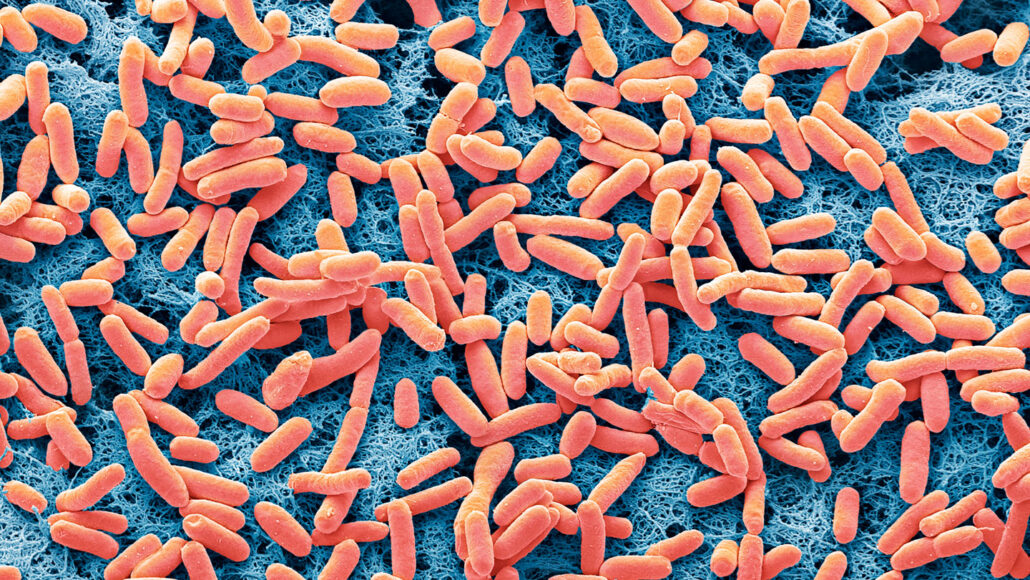bacteria: (singular: bacterium) Single-celled organisms. These dwell nearly everywhere on Earth, from the bottom of the sea to inside other living organisms (such as plants and animals). Bacteria are one of the three domains of life on Earth.
cell: (in biology) The smallest structural and functional unit of an organism. Typically too small to see with the unaided eye, it consists of a watery fluid surrounded by a membrane or wall. Depending on their size, animals are made of anywhere from thousands to trillions of cells. Most organisms, such as yeasts, molds, bacteria and some algae, are composed of only one cell.
chemical: A substance formed from two or more atoms that unite (bond) in a fixed proportion and structure. For example, water is a chemical made when two hydrogen atoms bond to one oxygen atom. Its chemical formula is H2O. Chemical also can be an adjective to describe properties of materials that are the result of various reactions between different compounds.
crop: (in agriculture) A type of plant grown intentionally grown and nurtured by farmers, such as corn, coffee or tomatoes. Or the term could apply to the part of the plant harvested and sold by farmers.
dengue: A potentially lethal infectious disease transmitted by mosquitoes. No vaccine yet exists to prevent infection with the virus responsible for the disease, which causes high fevers, severe headache, joint pain, pain behind the eyes, rash, bone pain and sometimes mild bleeding. A more severe form of the disease, known as dengue hemorrhagic fever can cause uncontrolled bleeding if not treated right away.
diabetes: A disease where the body either makes too little of the hormone insulin (known as type 1 disease) or ignores the presence of too much insulin when it is present (known as type 2 diabetes).
DNA: (short for deoxyribonucleic acid) A long, double-stranded and spiral-shaped molecule inside most living cells that carries genetic instructions. It is built on a backbone of phosphorus, oxygen, and carbon atoms. In all living things, from plants and animals to microbes, these instructions tell cells which molecules to make.
egg: A reproductive cell that contains half of the genetic information necessary to form a complete organism. In humans and in many other animals, ovaries produce eggs. When an egg fuses with a sperm, they combine to produce a new cell, called a zygote. This is the first step in the development of a new organism."
engineering: The field of research that uses math and science to solve practical problems. Someone who works in this field is known as an engineer.
gene: (adj. genetic) A segment of DNA that codes, or holds instructions, for a cell’s production of a protein. Offspring inherit genes from their parents. Genes influence how an organism looks and behaves.
genetic: Having to do with chromosomes, DNA and the genes contained within DNA. The field of science dealing with these biological instructions is known as genetics. People who work in this field are geneticists.
genetic engineering: The direct manipulation of an organism’s genome. In this process, genes can be removed, disabled so that they no longer function, or added after being taken from other organisms. Genetic engineering can be used to create organisms that produce medicines, or crops that grow better under challenging conditions such as dry weather, hot temperatures or salty soils.
GMO: An abbreviation for genetically modified organisms. These are organisms that people have altered, by tweaking their genes. In some instances, the genes may come from organisms totally unlike the species in which they end up.
insulin: A hormone produced in the pancreas (an organ that is part of the digestive system) that helps the body use glucose as fuel.
microbe: Short for microorganism. A living thing that is too small to see with the unaided eye, including bacteria, some fungi and many other organisms such as amoebas. Most consist of a single cell.
organism: Any living thing, from elephants and plants to bacteria and other types of single-celled life.
protein: A compound made from one or more long chains of amino acids. Proteins are an essential part of all living organisms. They form the basis of living cells, muscle and tissues; they also do the work inside of cells. Antibodies, hemoglobin and enzymes are all examples of proteins. Medicines frequently work by latching onto proteins.
salmon: A popular game fish that tends to live most of its life in the ocean, then enters coastal rivers (and freshwater) to breed and lay eggs.
spawn: To quickly cause something to come into being.
species: A group of similar organisms capable of producing offspring that can survive and reproduce.
trait: A characteristic feature of something. (in genetics) A quality or characteristic that can be inherited.
vaccine: (v. vaccinate) A biological mixture that resembles a disease-causing agent. It is given to help the body create immunity to a particular disease. The injections used to administer most vaccines are known as vaccinations.
yeast: One-celled fungi that can ferment carbohydrates (like sugars), producing carbon dioxide and alcohol. They also play a pivotal role in making many baked products rise.
Zika: A viral disease that can be transmitted to humans via mosquitoes. About 20 percent of infected people get sick. Symptoms include a slight fever, rash and pinkeye and usually fade quickly. A growing body of evidence suggests that the virus could also cause a devastating birth defect — microcephaly. Evidence suggests it may also cause neurological conditions such as Guillain-Barré syndrome.








